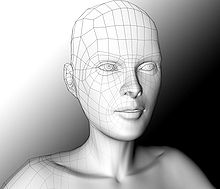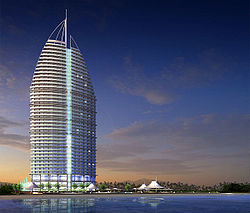- 3D modeling
-
This article is about computer modeling within an artistic medium. For scientific usage, see Computer simulation.
3D computer graphics 
Basics 3D modeling / 3D scanning 3D rendering / 3D printing 3D computer graphics software Primary Uses 3D models / Computer-aided design Graphic design / Video games Visual effects / Visualization Virtual engineering / Virtual reality Related concepts CGI / Animation / 3D display Wireframe model / Texture mapping Computer animation / Motion capture Skeletal animation / Crowd simulation Global illumination / Volume rendering In 3D computer graphics, 3D modeling (also known as meshing) is the process of developing a mathematical representation of any three-dimensional surface of object (either inanimate or living) via specialized software. The product is called a 3D model. It can be displayed as a two-dimensional image through a process called 3D rendering or used in a computer simulation of physical phenomena. The model can also be physically created using 3D printing devices.
Models may be created automatically or manually. The manual modeling process of preparing geometric data for 3D computer graphics is similar to plastic arts such as sculpting.
Contents
Models
3D models represent a 3D object using a collection of points in 3D space, connected by various geometric entities such as triangles, lines, curved surfaces, etc. Being a collection of data (points and other information), 3D models can be created by hand, algorithmically (procedural modeling), or scanned.
3D models are widely used anywhere in 3D graphics. Actually, their use predates the widespread use of 3D graphics on personal computers. Many computer games used pre-rendered images of 3D models as sprites before computers could render them in real-time.
Today, 3D models are used in a wide variety of fields. The medical industry uses detailed models of organs. The movie industry uses them as characters and objects for animated and real-life motion pictures. The video game industry uses them as assets for computer and video games. The science sector uses them as highly detailed models of chemical compounds[1] . The architecture industry uses them to demonstrate proposed buildings and landscapes through Software Architectural Models. The engineering community uses them as designs of new devices, vehicles and structures as well as a host of other uses. In recent decades the earth science community has started to construct 3D geological models as a standard practice.
Representation
 A modern render of the iconic Utah teapot model developed by Martin Newell (1975). The Utah teapot is one of the most common models used in 3D graphics education.
A modern render of the iconic Utah teapot model developed by Martin Newell (1975). The Utah teapot is one of the most common models used in 3D graphics education.
Almost all 3D models can be divided into two categories.
- Solid - These models define the volume of the object they represent (like a rock). These are more realistic, but more difficult to build. Solid models are mostly used for nonvisual simulations such as medical and engineering simulations, for CAD and specialized visual applications such as ray tracing and constructive solid geometry
- Shell/boundary - these models represent the surface, e.g. the boundary of the object, not its volume (like an infinitesimally thin eggshell). These are easier to work with than solid models. Almost all visual models used in games and film are shell models.
Because the appearance of an object depends largely on the exterior of the object, boundary representations are common in computer graphics. Two dimensional surfaces are a good analogy for the objects used in graphics, though quite often these objects are non-manifold. Since surfaces are not finite, a discrete digital approximation is required: polygonal meshes (and to a lesser extent subdivision surfaces) are by far the most common representation, although point-based representations have been gaining some popularity in recent years. Level sets are a useful representation for deforming surfaces which undergo many topological changes such as fluids.
The process of transforming representations of objects, such as the middle point coordinate of a sphere and a point on its circumference into a polygon representation of a sphere, is called tessellation. This step is used in polygon-based rendering, where objects are broken down from abstract representations ("primitives") such as spheres, cones etc., to so-called meshes, which are nets of interconnected triangles. Meshes of triangles (instead of e.g. squares) are popular as they have proven to be easy to render using scanline rendering.[2] Polygon representations are not used in all rendering techniques, and in these cases the tessellation step is not included in the transition from abstract representation to rendered scene.
Notable Concepts and abbreviations
In 3D modeling there are recurring concepts which usually appear as abbreviations. Here are some of the most current:
CW, center of window, in reference to the visualization window.
VRP, view reference point.
VPN, view plane normal.
VUV, view up vector.
FOV, field of view.
VRC, view reference coordinates.
WCS, world coordinates system.
Modeling Process
There are Three popular ways to represent a model:
- Polygonal modeling - Points in 3D space, called vertices, are connected by line segments to form a polygonal mesh. The vast majority of 3D models today are built as textured polygonal models, because they are flexible and because computers can render them so quickly. However, polygons are planar and can only approximate curved surfaces using many polygons.
- Curve modeling - Surfaces are defined by curves, which are influenced by weighted control points. The curve follows (but does not necessarily interpolate) the points. Increasing the weight for a point will pull the curve closer to that point. Curve types include Nonuniform rational B-spline (NURBS), Splines, Patches and geometric primitives
- Digital sculpting - Still a fairly new method of modeling, 3D sculpting has become very popular in the few short years it has been around.[citation needed] There are currently 3 types of digital sculpting: Displacement, which is the most widely used among applications at this moment, volumetric and dynamic tessellation. Displacement uses a dense model (often generated by Subdivision surfaces of a polygon control mesh) and stores new locations for the vertex positions through use of a 32bit image map that stores the adjusted locations. Volumetric which is based loosely on Voxels has similar capabilities as displacement but does not suffer from polygon stretching when there are not enough polygons in a region to achieve a deformation. Dynamic tesselation Is similar to Voxel but divides the surface using triangulation to maintain a smooth surface and allow finer details. These methods allow for very artistic exploration as the model will have a new topology created over it once the models form and possibly details have been sculpted. The new mesh will usually have the original high resolution mesh information transferred into displacement data or normal map data if for a game engine.
The modeling stage consists of shaping individual objects that are later used in the scene. There are a number of modeling techniques, including:
- constructive solid geometry
- implicit surfaces
- subdivision surfaces
Modeling can be performed by means of a dedicated program (e.g., form•Z, Maya, 3DS Max, Blender, Lightwave, Modo, solidThinking) or an application component (Shaper, Lofter in 3DS Max) or some scene description language (as in POV-Ray). In some cases, there is no strict distinction between these phases; in such cases modeling is just part of the scene creation process (this is the case, for example, with Caligari trueSpace and Realsoft 3D).
Complex materials such as blowing sand, clouds, and liquid sprays are modeled with particle systems, and are a mass of 3D coordinates which have either points, polygons, texture splats, or sprites assigned to them.
Compared to 2D Methods
3D photorealistic effects are often achieved without wireframe modeling and are sometimes indistinguishable in the final form. Some graphic art software includes filters that can be applied to 2D vector graphics or 2D raster graphics on transparent layers.
Advantages of wireframe 3D modeling over exclusively 2D methods include:
- Flexibility, ability to change angles or animate images with quicker rendering of the changes;
- Ease of rendering, automatic calculation and rendering photorealistic effects rather than mentally visualizing or estimating;
- Accurate photorealism, less chance of human error in misplacing, overdoing, or forgetting to include a visual effect.
Disadvantages compare to 2D photorealistic rendering may include a software learning curve and difficulty achieving certain photorealistic effects. Some photorealistic effects may be achieved with special rendering filters included in the 3D modeling software. For the best of both worlds, some artists use a combination of 3D modeling followed by editing the 2D computer-rendered images from the 3D model.
3D Model Market
3CT (3D Catalog Technology) has revolutionized the 3D model market by offering quality 3D model libraries free of charge for professionals using various CAD programs. Some believe that this uprising technology is gradually eroding the traditional "buy and sell" or "object for object exchange" markets although the quality of the products do not match those sold on specialized 3d marketplaces.
A large market for 3D models (as well as 3D-related content, such as textures, scripts, etc.) still exists - either for individual models or large collections. Online marketplaces for 3D content, such as TurboSquid, allow individual artists to sell content that they have created. Often, the artists' goal is to get additional value out of assets they have previously created for projects. By doing so, artists can earn more money out of their old content, and companies can save money by buying pre-made models instead of paying an employee to create one from scratch. These marketplaces typically split the sale between themselves and the artist that created the asset, often in a roughly 50-50 split. In most cases, the artist retains ownership of the 3d model; the customer only buys the right to use and present the model. [3]
3D Printing
3D printing is a form of additive manufacturing technology where a three dimensional object is created by laying down successive layers of material.
Human Models
The first widely available commercial application of human Virtual Models appeared in 1998 on the Lands' End web site. The human Virtual Models were created by the company My Virtual Model Inc. and enabled users to create a model of themselves and try on 3D clothing. There are several modern programs that allow for the creation of virtual human models (Poser being one example).
See also
- 3CT
- List of 3D modeling software
- List of common 3D test models
- 3D computer graphics software
- 3D scanner
- Additive Manufacturing File Format
- Cloth modeling
- Computer facial animation
- Digimation's Library example
- Digital geometry
- Edge loop
- Evolver is a portal, 3D modeler and market place for 3D characters
- Geological modeling
- Industrial CT scanning
- Open CASCADE
- Polygon mesh
- Polygonal modeling
- SIGGRAPH
- Stanford Bunny
- Triangle mesh
- Utah teapot
- Voxel
- Marching cubes
References
- ^ "3D Scanning Advancements in Medical Science". Konica Minolta. http://www.konicaminolta.com/sensingusa/application_notes/3D-Scanning/Applications-In-Medical-Science. Retrieved 24 October 2011.
- ^ Jon Radoff, Anatomy of an MMORPG, http://radoff.com/blog/2008/08/22/anatomy-of-an-mmorpg/
- ^ "3D Marketplace 3D Model Licensing Documentation". http://support.turbosquid.com/entries/170982-standard-royalty-free-license-faq. Retrieved 30 October 2011.
Categories:- 3D computer graphics
- 3D imaging
- Visual effects
- Video game design
Wikimedia Foundation. 2010.


